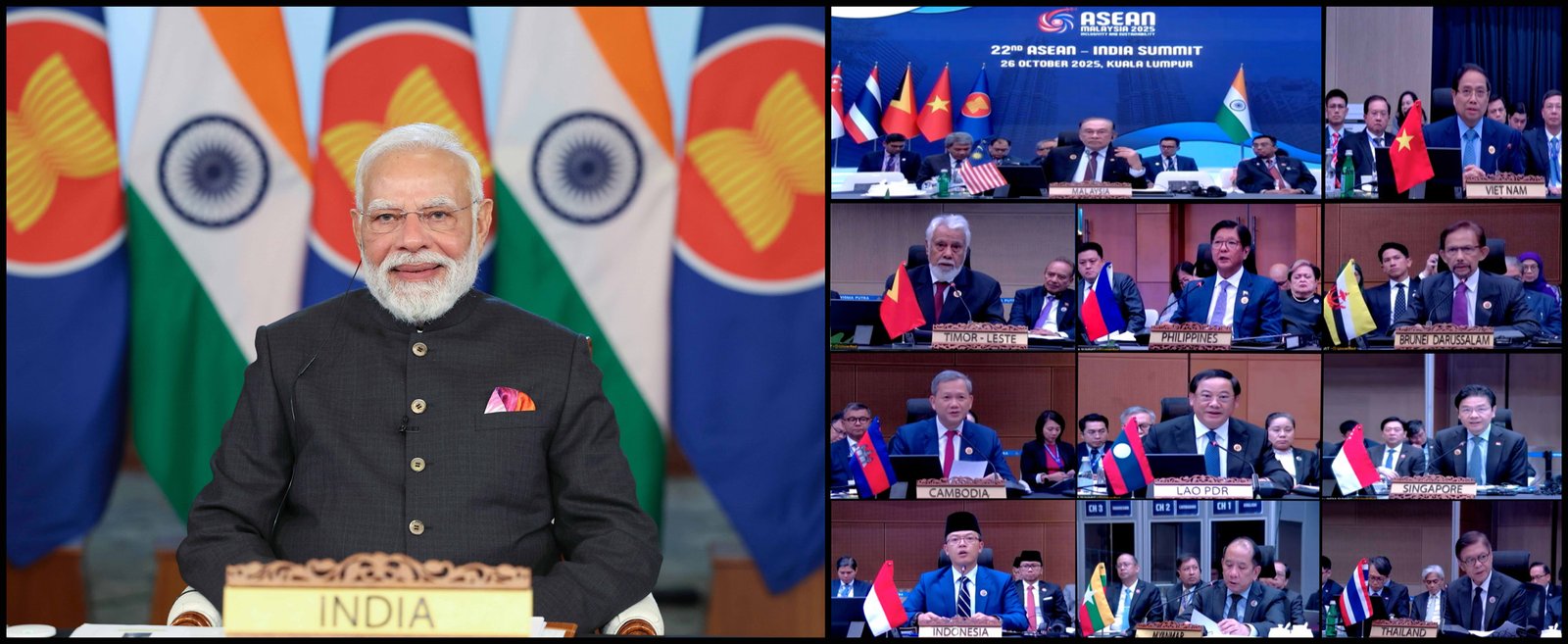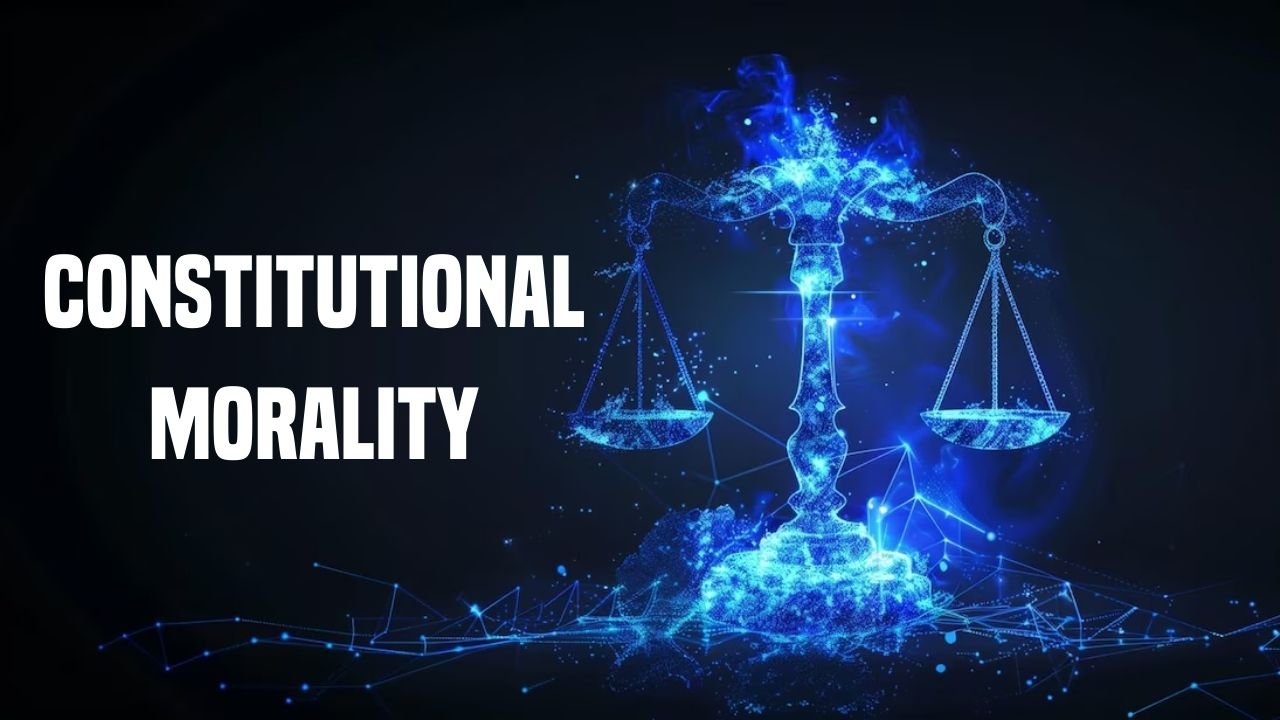Why in the News?
- Prime Minister Narendra Modi virtually addressed the 22nd ASEAN–India Summit held in Kuala Lumpur, Malaysia, and announced 2026 as the “ASEAN–India Year of Maritime Cooperation.”
- The summit reaffirmed the Comprehensive Strategic Partnership between India and ASEAN, focusing on maritime security, trade, cultural ties, and regional stability.
- The meeting came at a time when the world is facing an “era of uncertainties,” yet the India–ASEAN relationship continues to make steady progress.
Association of Southeast Asian Nations (ASEAN)
- Formation and Background
- Established: 8 August 1967
- Founding Members: Indonesia, Malaysia, Philippines, Singapore, and Thailand
- Formed through: Bangkok Declaration (ASEAN Declaration)
- Headquarters: Jakarta, Indonesia
- Motto: “One Vision, One Identity, One Community”
- Flag Symbolism: Represents peace, stability, and unity among member nations.
- Membership
- ASEAN currently has 10 member countries:
- Indonesia, Malaysia, Philippines, Singapore, Thailand, Brunei Darussalam, Vietnam, Laos, Myanmar, and Cambodia.
- Timor-Leste (East Timor) has been granted observer status (2022) and is on track to become the 11th full member in coming years.
- Objectives
- The primary goals of ASEAN are:
- Promote regional peace and stability through dialogue and non-interference.
- Accelerate economic growth, social progress, and cultural development.
- The primary goals of ASEAN are:
- Enhance cooperation in trade, education, science, and technology.
- Maintain Southeast Asia as a Zone of Peace, Freedom, and Neutrality (ZOPFAN).
- Strengthen resilience against external influences or rivalries.
- Key ASEAN Organs and Mechanisms
| Body / Mechanism | Purpose |
| ASEAN Summit | Highest decision-making body; held annually. |
| ASEAN Secretariat | Administrative and coordination hub, based in Jakarta. |
| ASEAN Regional Forum (ARF) | Security dialogue involving 27 countries (including India, USA, China, etc.). |
| ASEAN Free Trade Area (AFTA) | Promotes free trade and economic integration. |
| ASEAN Economic Community (AEC) | Aims for a single market and production base. |
| ASEAN Defence Ministers’ Meeting (ADMM+ ) | Cooperation on regional security and defence issues. |
- Key Milestones
- 1976: First ASEAN Summit in Bali; establishment of the Treaty of Amity and Cooperation (TAC).
- 1992: Launch of the ASEAN Free Trade Area (AFTA).
- 2007: Adoption of the ASEAN Charter, giving ASEAN a legal identity and defining its institutional structure.
- 2015: Formation of the ASEAN Community, comprising:
- ASEAN Political-Security Community (APSC)
- ASEAN Economic Community (AEC)
- ASEAN Socio-Cultural Community (ASCC)
- India–ASEAN Relations
| Aspect | Highlights |
| Start of Dialogue Partnership | Began in 1992 |
| Summit-level Partnership | Established in 2002 |
| Comprehensive Strategic Partnership | Upgraded in 2022 |
| Key Policies | Linked through India’s “Look East Policy” (1991) and “Act East Policy” (2014). |
| Trade Agreement | ASEAN–India FTA (2010) under AITIGA (Trade in Goods Agreement). |
| Connectivity Projects | India–Myanmar–Thailand Trilateral Highway, Kaladan Multimodal Project. |
| 2026 Initiative | Declared “ASEAN–India Year of Maritime Cooperation.” |
- Significance
- Strategic Location: Lies at the crossroads of the Indian and Pacific Oceans that are vital for global trade.
- Economic Powerhouse: Combined GDP exceeds $3.6 trillion, making ASEAN the 5th largest economy globally.
- Security Role: Acts as a balancing power amidst major powers (China–US–India).
- Cultural Link: Shared historical and civilizational ties with India, including Buddhism and maritime trade.
- Indo-Pacific Centrality: Plays a key role in maintaining peace, freedom of navigation, and rules-based order.
Key Highlights
- Setting the Tone: Partnership Amid Global Uncertainties
- PM Modi emphasized that even in a time of geopolitical uncertainty, the India–ASEAN Comprehensive Strategic Partnership continues to be a pillar of regional peace, stability, and growth.
- He described ASEAN as a “cultural partner” of India, highlighting the shared history, values, and civilizational connections that bind the two regions.
- He welcomed Timor-Leste as the newest member of ASEAN, underlining India’s commitment to inclusivity in the region.
- Economic Agenda: Revisiting AITIGA
- PM Modi urged an early review of the ASEAN–India Trade in Goods Agreement (AITIGA) to unleash the full economic potential of bilateral trade.
- He stated that both sides together represent nearly one-fourth of the global population and can act as engines of growth for the Global South.
- The review aims to address tariff and non-tariff barriers, streamline customs procedures, and promote balanced trade between India and ASEAN nations.
- Maritime Cooperation: 2026 Declared the “ASEAN–India Year of Maritime Cooperation”
- A major announcement was declaring 2026 as the ASEAN–India Year of Maritime Cooperation.
- This initiative will focus on joint naval exercises, maritime connectivity, blue economy, and marine resource management.
- It marks a strategic shift towards securing the Indo-Pacific waters, crucial for trade, energy, and regional peace.
- Broader Collaboration and Global Role
- PM Modi stressed India’s and ASEAN’s shared responsibility as companions in the Global South, pledging cooperation in:
- Digital inclusion and technology sharing
- Food security and resilient supply chains
- PM Modi stressed India’s and ASEAN’s shared responsibility as companions in the Global South, pledging cooperation in:
- Humanitarian Assistance and Disaster Relief (HADR) activities in the ASEAN region
- He also underlined collaboration in education, science and technology, green energy, and cybersecurity, while calling for unity against terrorism.
- The Prime Minister’s remarks concluded by reaffirming the century of India and ASEAN, projecting the 21st century as a time of joint progress and regional balance.
Implications
- Enhanced Maritime Security: The focus on the maritime year strengthens India’s role in ensuring safety and freedom of navigation in the Indo-Pacific.
- Trade and Investment Growth: A reformed AITIGA can expand India’s access to Southeast Asian markets and attract FDI from ASEAN.
- Strategic Balance in the Indo-Pacific: Deepening ties with ASEAN helps India counterbalance major power rivalries in the region while upholding ASEAN centrality.
- Regional Stability and Cooperation: Collaboration on disaster relief, digital connectivity, and food security enhances India’s role as a trusted development partner.
- Soft Power Diplomacy: Cultural, educational, and tourism-based ties strengthen India’s image as a benign and reliable partner in Asia.
Challenges and Way Forward
| Challenges | Way Forward |
| 1. Maritime Security Gaps: Limited coordination and capacity disparities among ASEAN navies hinder effective maritime monitoring. | Enhance joint naval exercises, establish shared maritime domain awareness systems, and provide training support for smaller ASEAN countries. |
| 2. Trade Imbalances under AITIGA: High tariffs and non-tariff barriers restrict fair trade growth. | Conduct an early review of AITIGA, simplify customs procedures, and ensure balanced benefits for all member states. |
| 3. Strategic Competition in the Indo-Pacific: Rivalries among global powers may affect regional unity. | Uphold ASEAN centrality, promote inclusive diplomacy, and avoid aligning with any one power bloc. |
| 4. Implementation Challenges in Development Projects: Commitments often face delays or insufficient follow-up. | Establish joint monitoring frameworks and time-bound project evaluations to ensure accountability. |
| 5. Uneven Economic Gains: Smaller ASEAN economies may lag behind in benefiting from India’s initiatives. | Offer capacity-building support, technology transfers, and targeted financial assistance through concessional lines of credit. |
Conclusion
The 22nd ASEAN–India Summit reaffirmed that the partnership between India and ASEAN remains one of mutual respect, shared prosperity, and cultural harmony. By declaring 2026 as the Year of Maritime Cooperation, India has signaled a renewed focus on maritime security, blue economy, and connectivity. Moving forward, the success of this partnership will depend on implementation of trade reforms, stronger regional institutions, and people-centric cooperation that together ensure peace and prosperity in the Indo-Pacific.
| EnsureIAS Mains Question Q. Discuss the significance of India’s Comprehensive Strategic Partnership with ASEAN in strengthening regional security and economic integration. How does maritime cooperation contribute to India’s Indo-Pacific strategy? (250 Words) |
| EnsureIAS Prelims Question Q. Consider the following statements: 1. India declared 2026 as the ASEAN–India Year of Maritime Cooperation during the 22nd ASEAN–India Summit. 2. The Prime Minister described ASEAN as India’s “Cultural Partner” and urged an early review of the AITIGA agreement. 3. External Affairs Minister S. Jaishankar led the Indian delegation at the 22nd ASEAN–India Summit held in Kuala Lumpur. How many of the following statements are correct? Answer: d) 1, 2 and 3 Explanation: Statement 1 is Correct: India declared 2026 as the ASEAN–India Year of Maritime Cooperation to strengthen maritime security and connectivity. Statement 2 is Correct: PM Modi referred to ASEAN as a “Cultural Partner” and called for an early review of AITIGA to boost trade. Statement 3 is Correct: While PM Modi joined virtually, EAM S. Jaishankar represented India physically at the summit. |
Also Read | |
| UPSC Foundation Course | UPSC Daily Current Affairs |
| UPSC Monthly Magazine | CSAT Foundation Course |
| Free MCQs for UPSC Prelims | UPSC Test Series |
| Best IAS Coaching in Delhi | Our Booklist |




